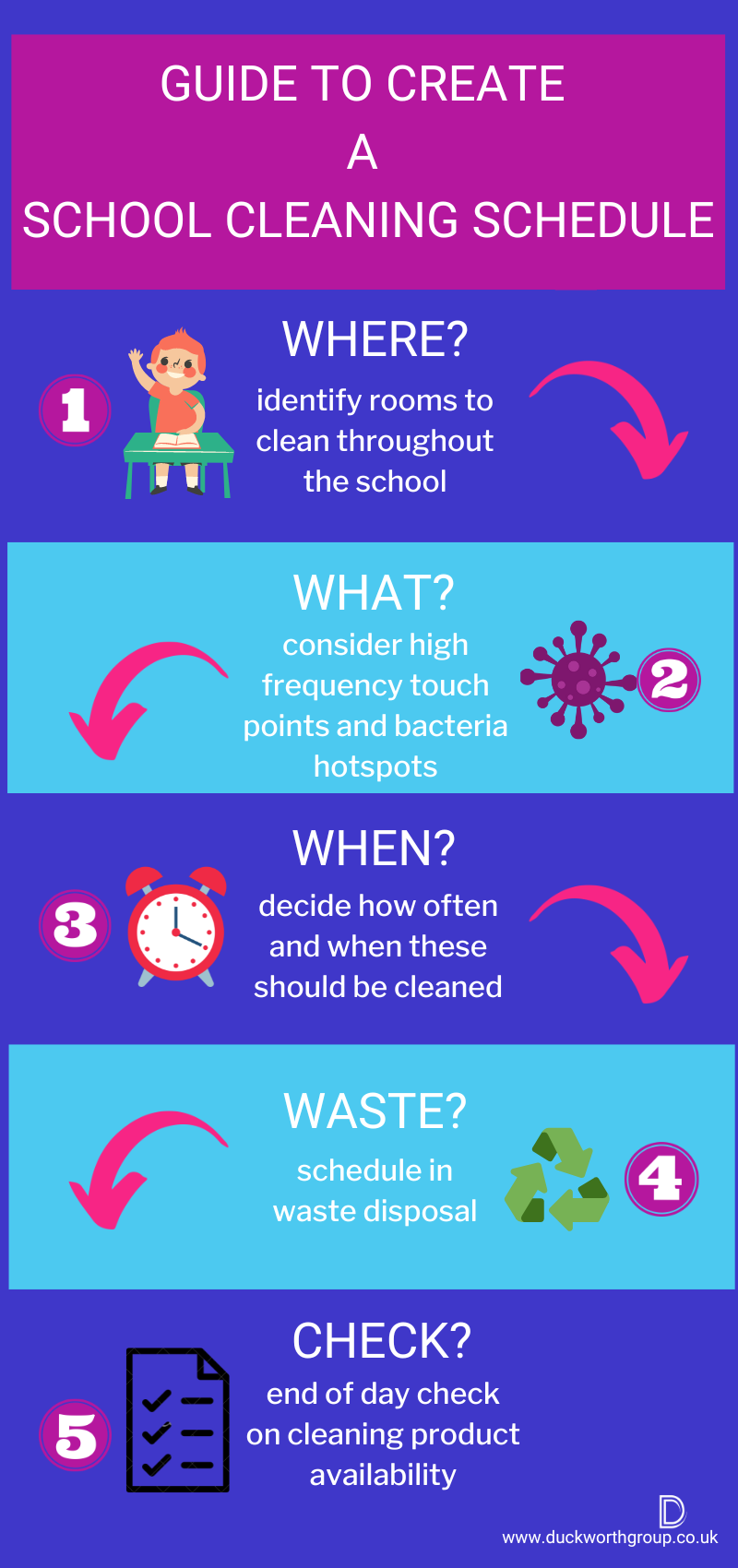5 Top Tips for Creating an Effective School Cleaning Schedule
As the school supervisor, it's part of your duties to ensure your school is regularly cleaned throughout. However, it can be easy to fall behind on a school cleaning schedule for a variety reasons.
According to research, it is believed that school-aged children are highly likely to catch covid and other viruses; it makes sense when hundreds of people are in a building and can be coughing and sneezing all day long.
And, when the school day is over, there's rubbish and half-eaten food everywhere. Your school cleaner can only do so much!
The best way to make sure your school building is germ-free is by following a consistent school cleaning schedule that is easy to manage and gives you the right results.
1. Have All of the Right Cleaning Supplies
Before creating your school cleaning schedule, you must have the right hygiene products and cleaning supplies. Since schools have a dense population, you will need products that are strong enough to kill germs but not full of harsh chemicals.
Check out our essential cleaning products for schools which gives you all the basic products you need for your school cleaning schedule.
The air in schools can often be poor, and some cleaners can be harmful to children's respiratory health. This is especially true for children who suffer from asthma and bronchitis. We have a close relationship with a brand called Clinell who design products that protect from virus' and bacteria; the now supply an air purifier that is perfect for classrooms and rooms throughout a school, that cleans the air on a frequent basis. Contact us if you are interested to learn more on this product.
2. Choose Closed School Days to Deep Cleaning
It is impossible to conduct a truly deep clean a school while children, teachers and staff are on the premises. As schools often have holidays, this is a great time to schedule a deep clean for every area across your school. When the time comes, section off all the rooms and plan out how to clean them thoroghly, so every corner and inch gets cleaned. The way you clean high traffic areas such as the hallways, bathrooms, classrooms, and cafeteria should be thoroughly planned.
Planning allows you to reduce costs, hire staff, and simplify your operations.
3. Make Sure Staff Members Know the School Cleaning Schedule
Try not to keep your school cleaning schedule a secret and tell staff members at the last minute. Doing so will only upset the teachers and other school staff as they may have plans for other activities during this time. They can also provide input as to how this can be done for optimum efficiency.
Keeping a school clean requires teamwork, and if you want other members to join in, tell them ahead of time. Make a school cleaning schedule before the new school year and discuss it with everyone, so everybody is clear as to what is going on and has confidence that the school is efficiently and sufficiently cleaned throughout the academic year. It's also a good time to tell them how to clean their classrooms and what cleaning supplies they should use and how they work.
Once staff members return from the break, you can discuss your cleaning plan. Teachers should take specific measures to keep their classrooms, lounges, and other areas spotless. Remember, a clean environment helps promote better learning among students, so a discussion of cleanliness is essential with all members of staff who use the facility.
4. Regular Cleaning Involves Disinfecting the Germiest Places

Did you know that 68% of students do not like to use school bathrooms because they are always stinky and dirty?
You can't blame students for being like this with school bathrooms, because who wants to be in a toilet that smells and have dirty tissues everywhere. No one! Bathroom hygiene should be a priority.
During your deep cleaning, you should take extra care to make sure every spot is disinfected. Some other places you should focus on disinfecting include high traffic and used areas such as student desks, doorknobs, cafeteria tables, gym equipment, and water faucets.
Anywhere you think students will touch is an area you need to disinfect. So, don't forget to wipe down the computer lab or music room too during your deep cleaning schedule.
5. Teach Students How to Keep a Clean Classroom and Environment
Once again, keeping a school clean involves teamwork, and it shouldn't be all about you and the staff members. You can motivate the students to keep their environment clean by explaining the importance of cleaning and hygiene and throwing rubbish away.
Put recycling bins everywhere around the school to teach them how to recycle. Also, we recommend to have rules on what will happen if students are caught trashing the school.
They may not like it, but it'll teach them essential skills for the future. Possibly have an assembly on how they can take part in keeping the school clean. Discuss the importance of regular handwashing and how it can stop germs from spreading.
You can put up posters around schools to remind students about the importance of hygienic habits. Finally, you could let students bring cleaning supplies like wet wipes to disinfect their own desks and school supplies.
Building your school cleaning schedule can be challenging to do on your own. Also, schools often have a high turnover rate for janitors and other staff members. If you keep hiring more people to clean your school, you'll lose money and won't have any leftover for other resources. Make sure your school stays clean by having the right cleaning supplies continuously in stock.
Check out our school cleaning products to see what products you can use to help you create a safe and healthy environment for your students.




